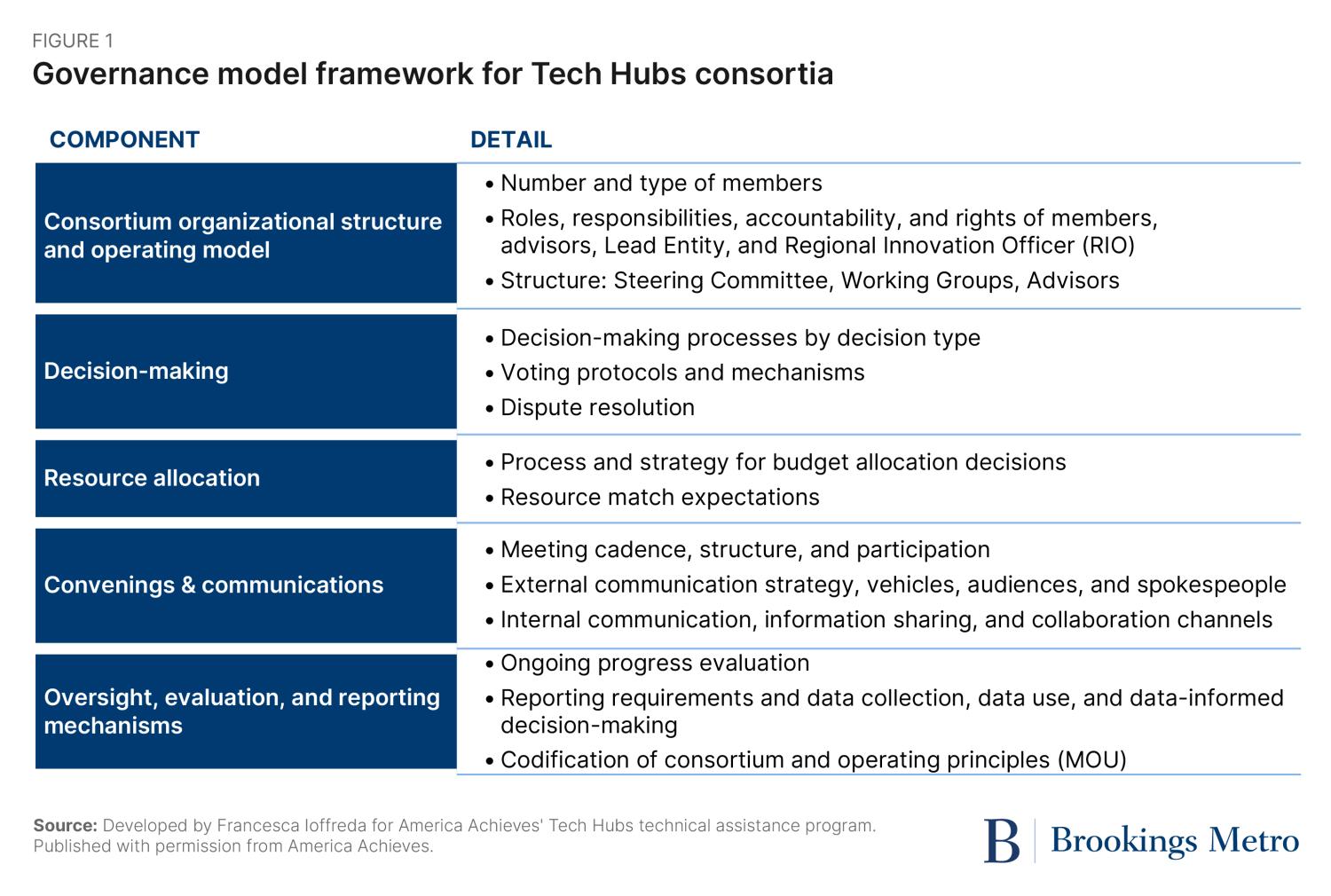By mid-August, the Economic Development Administration (EDA) had received 379 applications from 48 states for Phase 1 of its Regional Technology and Innovation Hubs (Tech Hubs) competition, which seeks to boost tech clusters in diverse places and accelerate equitable growth and competitiveness. Now, the agency has announced some winners.
This week, the Biden administration designated 31 winning regions that will receive support and possible investment to scale-up their local advanced industries. In the coming months, the 31 hubs will have the opportunity to compete for $500 million of implementation funding in a Phase 2 competition. At the same time, 18 other regions will receive smaller grants to develop their plans to receive designation (and possibly investment) in the future.
In keeping with all that, the new announcement stands out as a material example of the nation’s ongoing, multi-program drive to boost national economic dynamism by leveraging what we call “place-based industrial policy.”
The Tech Hubs program was envisioned by Brookings Metro and others and funded through last year’s CHIPS and Science Act, and this week’s designations represent an initial deposit on its authorized (but under-appropriated) $10 billion investment to build new growth capacity in new places. As such, the designations aim to boost innovation in local clusters, enable commercial scale-up, and develop the workforce of the future—all while achieving key national goals such as securing America’s national security, improving its supply chain resilience, redoubling its technology leadership, and improving economic inclusion.
In that sense, this week’s announcement makes public a bold set of bottom-up, vetted strategies for supercharging local tech ecosystems with place-based investment. Regions of all sorts will therefore want to study the winners’ array of leading-edge local practices. Here are a few takeaways.
Tech Hubs designations represent a national push to build global economic leadership by unleashing the technology potential of more regions
One thing to note is that the new designations represent the latest affirmation of the idea that intentional efforts to unlock growth in new places represent a plausible strategy for advancing the nation’s technology frontier—and thereby its global competitiveness.
This is shown by designations in autonomous systems in Tulsa, Okla. and Montana; semiconductors in Upstate New York and Oregon; and quantum computing in Colorado and Chicago. With initiatives like these, the program is teeing up key tests of the logic of the nation’s new embrace of place-based industrial strategy.
For one, the designations—especially when followed by implementation grants—will test the idea that focused growth strategies targeted on promising but underperforming locations can intervene meaningfully in the drift and divergence that characterize too much of the nation’s geography of innovation. Yet beyond that, any future hubs will also help assess the ability of place-based interventions to address the local and “micro” underpinnings of “macro” performance issues, so as to accelerate innovation and technology development.
In that sense, this week’s Tech Hubs designations are an important signal not just of local tech potential, but also of national and global aspiration. They are a bid to get more of the American economy closer to the technology frontier through place-based industrial strategy.
The 31 designations represent a diversity of technologies and geographies
Notwithstanding that sharp strategic focus, the reach of the Tech Hubs designations is broad. The regions receiving designations encompass 32 states and span the technological and geographic entirety of the U.S. economy.
Technologically, the program has identified high-potential clusters across 10 “key technology focus areas” laid out by the CHIPS and Science Act, including artificial intelligence, biotechnology, advanced computing and semiconductors, and advanced energy technologies. In addition to generating considerable economic value and wealth in the coming years, these technologies are also critical to advancing U.S. interests related to geopolitical competition, climate change, and economic security.
Within the broader federal push to invest in these technologies, the Tech Hubs program’s distinct contribution is to build the regional ecosystems required to translate basic and applied research into innovation and quality economic growth. That means picking regions that have strong, but perhaps undercoordinated, technological assets—what economists call “latent capacity” within a local economy. A few examples include the University of Illinois’ precision fermentation strategy; Miami’s climate resilience initiative; and Oregon State University’s mass timber coalition.
In that sense, the 31 designated Tech Hubs move decisively beyond the coastal boundaries of self-sustaining knowledge capitals such as the Bay Area, Boston, New York, and Seattle, and engage the next frontier of U.S. technology development in a new set of territories. Spanning all corners of the nation, these 31 regions account for 20% of the U.S. population, 21% of U.S. STEM workers, and 20% of U.S. jobs in advanced industries.
The Tech Hubs will also be nationally relevant sites to advance economic and racial inclusion. Across the 31 designees, Black Americans represent roughly 15% of the overall population, and Latino or Hispanic Americans make up approximately 18%. However, the representation of these groups in advanced industry jobs in those places is notably lower, with Black individuals holding only 10% and Latino or Hispanic individuals holding only 11% of these roles—well below their respective population shares. For these regions to meet their technology potential, economic and racial inclusion must be a central consideration.
In sum, this week’s awards show the nation seeking to include more places and more people in the dynamic future of technology.
Regional winners now need to enhance governing capacity and readiness
For these 31 regions, the challenging work of bringing these bold visions to fruition begins now. To realize the inclusive economic potential of the Tech Hubs effort, the consortia in each region will have to deliberately coordinate the activities, strategies, and investments of many regional actors around an innovation agenda for years to come. Consortia must focus on enhancing their implementation readiness and governing capacity starting today.
Practically speaking, this means that consortia will need to refine their membership and operating models, prioritize key projects, and align on decisionmaking processes, communication strategies, and impact measurement approaches—all with a sharp focus on equity and inclusion. Figure 1 outlines the foundational governance elements that will better equip consortia to operate effectively under common principles and allocate financial, human, and other resources in a way that maximizes their impact and community benefit.

Building this governing capacity means asking fundamental questions. Do consortia have the right leadership and organizations at the table? Do they have sufficient internal capacity? How about the right partnerships? Are projects as impactful as they could be? This process is an essential step to getting buy-in, building trust, and promoting transparency, representation, and accountability among stakeholders. With a shared and clear-eyed picture of the vision, current state, and existing tensions to be managed, consortia will be better positioned to plan for the people, projects, and resources that can meet their region’s unique needs.
One of the early questions consortia will confront is which projects to prioritize and how to do so in a way that promotes interconnectivity, addresses inhibitors to global competitiveness, and benefits underserved communities. Consortia that invest in building a thoughtful and robust governance model will have a strong base for making decisions that boost the long-term collective and adaptive capacity of their initiatives.
With this designation hurdle cleared and consortia facing both the tantalizing opportunity and the complexity of accelerating commercialization of new technologies, now is the time for fortunate consortia to work hard on their governance models—as well as everything else. Success at stitching together diverse cross-sector coalitions—and managing across sometimes broad geographic footprints—will ultimately depend on readiness and governance.
Winning regions can deliver on the nation’s urgent missions
In the end, the Tech Hubs designations are an important juncture in asserting the globally significant potential of U.S. regions. With the designations done and implementation grants ahead, it’s now “game on” for the 31 regions to deliver on the nation’s grand missions.






Commentary
What the new Tech Hubs designations mean for boosting innovation across the US
October 23, 2023